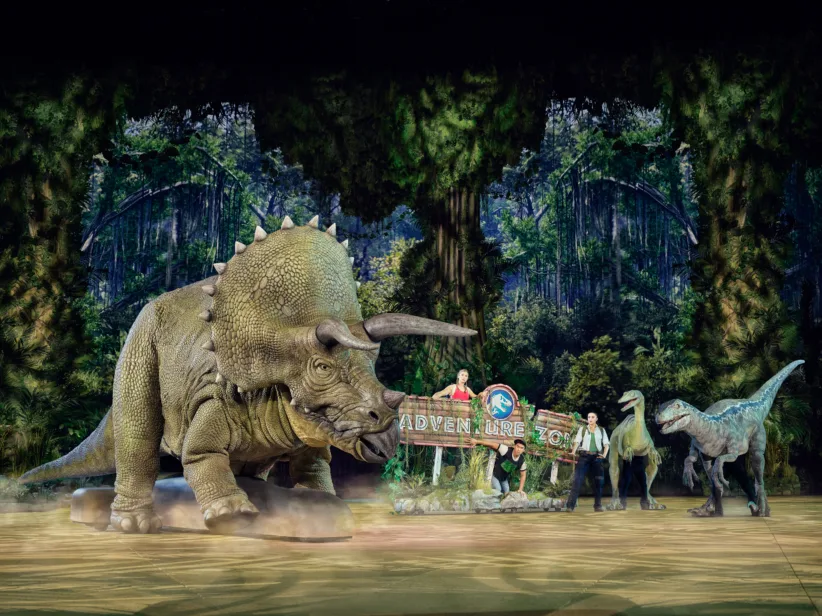Films enjoy — or suffer from — a distinction no other technology or art does: The idea that audiences understand them inside out. Seeing moving images as frequently as we do in movie theaters, on television, through video games and through our computers, we’ve come to feel something like homegrown experts. As media critics frequently point out, moving images are everywhere, and their effect, as the pictures from September 11 recently reminded us, are as potent as ever. Being able to read an image is a new kind of literacy, which some people feel they possess simply as the result of frequent exposure. But how many of us really understand the psychology and technology of moving images?
The American Museum of the Moving Image has the perfect emblem for its mission of educating the public about the art, history, technique and technology of film, television and digital media: A human eye. The unblinking orb hovers just above the museum’s roof on 35th Avenue in Astoria, serving as witness to the neighborhood’s own past and present in the film and television industry; only about 100 yards away, Kaufman Astoria Studios (formerly known as the Astoria Studio), built by Paramount Pictures in 1920, continues to function as a lively production facility. The massive city-block structure, in which the Marx Brothers, among countless others, have made films, has since lent its stages to the makers of contemporary classics such as All That Jazz, Arthur and The World According to Garp.
The museum’s history is, in fact, directly related to the studio’s rebirth. In 1942, the studio ceased commercial film production when it was taken over by the U.S. Army for the purpose of producing instructional films for wartime inductees. After 1971, the studio fell into a state of disrepair, but was restored to active production as the result of the establishment in 1977 of the Astoria Motion Picture and Television Center Foundation. In 1981, the foundation’s director, Rochelle Slovin, suggested revising and expanding the concept of the studio to include a museum of film and television. The American Museum of the Moving Image opened in an adjacent building in 1988.
Now in possession of a total of 95,000 objects, the bulk of the museum consists of a permanent exhibition called “Behind the Screen”, in which 12,000 of those objects tell the story of moving pictures, from 19th-century parlor toys to present-day digital technologies. As with many museums today, a number of Moving Image’s galleries contain kid-friendly interactive displays, beginning here with the Zoetrope, dating from approximately 1834. (Film aficionados will recognize the name as that of Francis Ford Coppola’s production company). The Zoetrope is a drum lined on its inside with illustrated pictures — in this case, of a running man — which appear to move when the drum is spun and the slits at the top edge of the drum are peered through. From the same period but slightly more involved, the Phenakistoscope is a vertically mounted circular disk illustrated with uncoiling snakes; the disk faces a mirror that reflects the movement of the snakes back to the viewer (through the openings in the disk) when the disk is rotated quickly enough. The most simple of the early optical toys, the 1825 Thaumatrope, is a cardboard disk, similar in size and shape to a coaster, with a bird on one side and a birdcage on the other. Mounted on an elastic string and unleashed rapidly, the “bird” suddenly appears inside its cage.
These toys, together with a marvelous kinetic sculpture by Gregory Barsamian called “Feral Fount”, drive the point home simply and entertainingly: that moving images are illusions. “Feral Fount” is a rapidly rotating armature affixed with 97 small sculptures, each differing slightly from the preceding one; the armature’s dizzying spin, combined with the effect of a strobe lamp, make a convincing case that the viewer is seeing a drop of water transform itself into a bomb shape and eventually into a paper airplane that shatters a dish at the bottom of the sculpture. “Fount”, along with its earlier counterparts — including a pair of fully operational hand-cranked Mutoscope viewing machines — illustrate the phenomena of “persistence of vision” — a characteristic of human perception in which an image remains on the retina for a split second after it disappears, allowing us to see continuous moving images where none actually exists. (Peter Mark Roget, of Thesaurus fame, defined persistence of vision scientifically in the 1820s).
As the sophistication of film and video technology evolves, so do the museum’s interactive exhibits. Kids, and adults, can make video “flipbooks” of their body movements; or project their images, via the video technology known as Chroma Key, into the background and foreground of their choice. (If you ever wanted to be a TV weatherman, this is definitely your chance). Those interested in animation can make their own little films, frame-by-frame, at computer animation terminals. Meanwhile, budding actors can practice their “looping” — better known as dubbing — to some classic film clips in the museum’s sound recording booth. Demonstrations of film editing, computer-generated imagery, and animation are held three or four times a day. The institution’s display of both film and television cameras, editing and sound equipment, lighting devices, merchandizing, and special effects technology are superb. (In regard to special effects, parents with very young children should be conscious of the exhibit of Linda Blair’s doll likeness from The Exorcist, or the ferocious mechanical puppets used for the horror film Wolfen). For live TV enthusiasts, there’s even a TV control room set-up where visitors can listen to a recording of director Bill Webb handling a 1998 Yankee broadcast.
The museum also houses, strictly for entertainment purposes, the completely wonderful “Tut’s Fever Movie Palace”, a combination Grauman’s Egyptian Theatre/fun house for kids designed by Pop master Red Grooms and Lysiane Luong. Tiny but with more magnificent details inside it to mention here, the theater houses screenings of classic movie serials — through September 13, 1938’s The Spider’s Web; and beginning September 14, 1937’s Blake of Scotland Yard. Roll film.
The American Museum of the Moving Image is located at 35th Avenue at 36th Street in Astoria. For more information, call (718) 784-0077 or go to www.ammi.org.





















